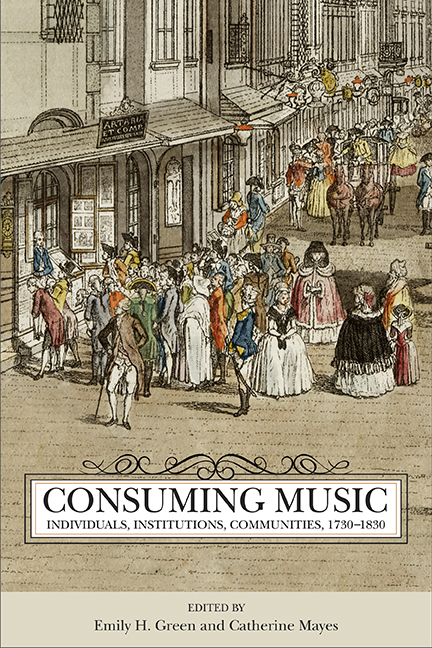Introduction
Published online by Cambridge University Press: 26 April 2018
Summary
In a print by Carl Schütz from 1786, a rather large crowd gathers in front of Artaria's shop in Vienna (fig. I.1). Among the roughly two dozen well-dressed individuals, some inspect the shop window, while others try to peer into the store itself, presumably to gather an impression of its offerings beyond those on display. The Kunsthandlung, as the shop billed itself, might be advertising engraved pictures, maps, or even music; Schütz's faint scribblings obfuscate the exact nature of the wares exhibited. Based on available evidence, we can't know what curious onlookers might have seen, either in the window or beyond. Like the viewers on the street, we are left, rapt, with an incomplete picture of the contents of the store and its windows.
A later print, Franz Weigl's aquarelle of Steiner and Haslinger's shop ca. 1835 (fig. I.2), takes us inside a Viennese Kunsthandlung, but again no music is visible. Rather, one sees shop attendants, customers, prints of visual art, books one can assume to be shop registers, and commemorative busts. The only sounds in the room presumably emanate from the conversations among the buyers and attendants in the room. A transaction might be taking place, but it likely concerns a picture of some sort rather than anything musical.
These two prints are vivid reminders that the successful sale and distribution of music depended on much more than the quality of the ideas on the page: musical commerce involved both a physical and a social infrastructure. Though the existence of that infrastructure is most likely obvious, its organization and participants are among the least well-preserved and thus least-understood elements of the musical culture of the common-practice period: who bought music, and how did those consumers know what music was available? Where was it sold and by whom? How did the consumption of music affect its composition? How was consumers’ musical taste shaped and by whom? The documentary difficulty one encounters when attempting to answer such questions has been an impediment to engaging in more complex historical inquiries about consumers’ tastes, publishers’ promotional strategies, celebrity culture, and the wider communities that were fundamental to these and many more aspects of musical life in the eighteenth and nineteenth centuries.
- Type
- Chapter
- Information
- Consuming MusicIndividuals, Institutions, Communities, 1730–1830, pp. 1 - 10Publisher: Boydell & BrewerPrint publication year: 2017



